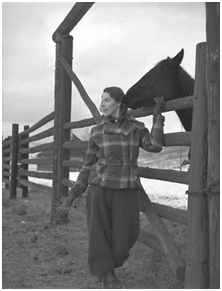
“Beau and young Morgan stallion at Lamar Ranger Station, February 9, 1941.” Based on the date, the horse is either Wakefield Duke or Black Baron. Photo: Ernest R. Augustin, Jr., Photographs, #YELL 185380.3177, Yellowstone National Park Archives
Although one old proverb asserts that, "a good horse comes in any color," riders often favor one particular breed.The same is true - to a certain degree - in the National Park Service, which has a long tradition of mounting their rangers on Morgan horses.Morgans were one of the first breeds developed in the United States, and are known for their versatility, endurance, and intelligence.One example of this connection is the Morgan Horse Farm at Point Reyes National Seashore. Established in 1968, the farm's original goals included breeding and training Morgans, which were kept for patrol duty at Point Reyes as well being sent off for use at other national parks.
Here in Yellowstone National Park, the use of Morgans is much older, although little is known about their early years. Recently, several researchers have contacted us, asking for information about the Morgan horses used and raised in Yellowstone. One investigator is a family member of Jack Richard, whose collection at the Buffalo Bill Historical Center includes many images of rangers riding Morgans, such as this example from 1960 of Ranger Bob Richard on Big Red.
A year ago we were unable to provide much information about Yellowstone's Morgans, but some recent discoveries in the park's archives have allowed us to piece together some of the story.The first breakthrough was the discovery of a 1948 report titled "Analysis of Horse Breeding Program at Lamar Unit."This document states that the breeding program at Yellowstone began in the spring of 1941, and gives us the names of the three Morgan stallions in the park: Wakefield Duke, Black Baron, and Gipsey Chief.A little more detective work revealed that all three of these horses had the same sire - Gipsey King.
Like all famous horses, Gipsey King has an impressive pedigree, but perhaps not one you'd expect.He was donated to the National Park Service in May 1937 by John D. Rockefeller, Jr..Gipsey King was stabled and bred at George Washington Birthplace National Monument, and the park's superintendent is said to have jumped at the opportunity to produce mounts for other parks within the National Park Service. It would seem that his plan met with some success since three of Gipsey King's colts were in Yellowstone only a few years later.
Yet another discovery was made earlier this month when a photograph of one the Morgan stallions was found in a collection of photographs by Ernest R. Augustin, Jr. Based on the date, this 1941 photo must be of Wakefield Duke or Black Baron.
Despite these famous connections, we don't know what happened to Duke, Baron, Chief, or the other Morgan horses of Yellowstone: much of their story is yet to be told.There's an old cowboy saying that states, "A dog may be man's best friend, but the history of the West was written by the horse."If that's true, then perhaps the contributions of Morgan horses to Yellowstone and other national parks will not be forgotten.
Sources: Bruggeman, Seth C.George Washington Birthplace National Monument: Administrative History, 1930-2000 (2006); Ernest R. Augustin, Jr., photographs (MSC 17), Yellowstone Park Archives; Sadin, Paul.Managing a Land in Motion: An Administrative History of Point Reyes National Seashore (October 2007); Smith, Larry."Harold D. Smith: ASPA Founder and Trusted Advisor to FDR."ASPA Times.(26.8).
